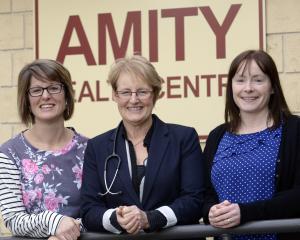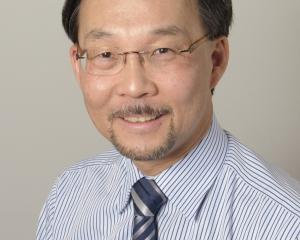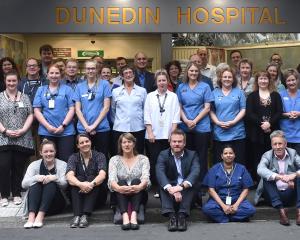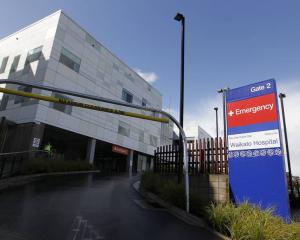Sixty people enrolled with the Mornington primary health organisation (PHO) did not know they had diabetes until they were offered a free check under a new programme to target at-risk people.
The programme was just one of several initiatives the Mornington Health Centre has been able to introduce under the PHO system, chief executive Barbara Bridger said.
PHOs were introduced in 2002 under the Government's Primary Health Care Strategy with the aim of improving health in communities and reducing inequalities in accessing health care.
While improved management of chronic conditions such as diabetes should eventually lead to fewer hospital admissions, the Mornington PHO was already getting measurable results for patients in other areas, Mrs Bridger said.
Within a year of introducing a mental health service for people with mild to moderate mental health illness, the number of referrals to secondary treatment halved.
Previously, people suffering depression or anxiety had a 15-minute consultation with a GP which gave little satisfaction to patient or doctor, she said.
The PHO employed two mental health nurses for the service.
Taieri and Strath Taieri PHO board member and Mosgiel Health Centre GP Richard Muir said there had been a huge increase in funding for primary health care since the introduction of PHOs, and it had been " thankfully received".
Cheaper doctors' visits for everybody enrolled in a PHO meant more people were seeing their doctor, Dr Muir said.
"It has improved access for people in our population."
Visits for children under 6 are free at many practices, the Care Plus programme provides subsidised care for people who have to visit a GP or nurse frequently because of a chronic condition, and the final element of subsidised doctors' visits was introduced last year, with fees for 25 to 45-year-olds ranging from $15 to $37.50 in Otago.
Rural GP Tim Gardner, of Outram, said the PHO system enabled doctors to be pro-active about the health of their patients, as opposed to the traditional "knee-jerk reaction" of seeing patients only when they were sick enough to come to the doctor.
The Taieri area had one of the highest percentages of people over the age of 65 and the Taieri and Strath Taieri PHO had identified chronic health as a major issue.
The PHO was in the process of employing a nurse to provide pro-active chronic health care across all three practices in its area.
"I think the whole idea of PHOs has slowly gained traction.
"I'm not surprised it has taken so long because it has been a total mind shift for doctors and nurses.
There is some resistance to breaking out of the old model."
Dr Gardner said he dreamed of bigger and better PHOs which embraced the entire primary health sector, including midwives, pharmacists, physiotherapists and dentists.
"I haven't found any coherent answer to why that cannot be done."
South Island PHO Chairs Forum chairman John Kelly, of Mosgiel, who is also the Taieri and Strath Taieri PHO chairman, said after a slow start, enthusiasm was growing among PHO board chairmen.
"They are all talking very positively about what they are doing in their own area."
Individual PHOs were becoming more autonomous, developing their own resources and employing their own staff, he said.
However, Queenstown GP Hans Raetz does not share this enthusiasm.
PHOs were simply another expensive layer of bureaucracy, Dr Raetz said.
With 81 PHOs and 21 district health boards around the country, the numbers spoke for themselves, he said.
"That is 102 different health administrations for a place the size of New Zealand, with four million people.
"Having local representation with one PHO every 5km, it's not going to work."
PHOs were geared towards reducing inequalities in accessing health care and as Queenstown was seen as "a rich place" they did not get enough money, he said.
The PHO system had not brought any benefit for people in the Queenstown area, except for the introduction of a nursing service half a day a week in Glenorchy, which took one year to get past the health board, he said.
PHO funding is provided through district health boards from the Ministry of Health .
By that stage he "had a gutsful" and resigned as Wakatipu PHO director last year, Dr Raetz said.
"I think for most areas the answer lies in large PHOs that can have a better influence over their respective district health boards."
Dr Muir, of Mosgiel, said having to get approval for new initiatives from district health boards could substantially slow the process and was a source of frustration.
PHOs were starting to make their own decisions and moving beyond simply being a conduit for funding, he said.
"PHOs have grown up. Now they are starting to perform the governance role so much better they need to have some independence.
"I hope the district health boards and those above will develop a capacity to give us more freedom to make our own decisions."
PHOs allowed more community ownership of healthcare and the Taieri and Strath Taieri board had good community representation, Dr Muir said.
"In the end, we are trying to deliver a service to the community."
Otago District Health Board chief planning and funding officer Chris Fraser said some PHOs did express frustration about funding constraints, but the reality was "government policy was government policy".
"I think the PHOs who are in tune with the national strategy tend to get things approved quickly."
Many PHOs were "starting to emerge from their shells" and eventually they would probably have more independence, he said.
However, PHOs and district health boards were still on a steep learning curve.
"Autonomy is something that you earn," Mr Fraser said.
The increasing visibility of PHOs in the community was a tangible sign PHOs were progressing, he said.
They were shifting from being "virtual identities" with a board meeting once a month, to organisations employing their own staff, including managers, and renting their own office space.
Independent practitioners association South Link Health general manager Richard Whitney said the "average person on the street" would have little idea of what PHOs were and what they did.
The way general practice received funding did not hold much immediate relevance for patients, he said.
"However, we are pragmatic in an environment that has changed.
"What is important at the end of the day is that general practice is well supported so they can best support the patients they service."
Vital statistics
- A PHO is a local non-profit organisation for delivering and co-ordinating health care in the community.
- They bring together GPs, nurses and other health professionals. PHOs are governed by a board including medical, community and iwi representation.
- 95% of New Zealanders are enrolled in a PHO.
- Most general practices belong to a PHO.
- PHOs get a set amount of funding from the Ministry of Health through district health boards to subsidise a range of health services.
- They provide care and treatment for sick people, help people to stay healthy and reach out to groups in their community who have poor health or are missing out on health care.
- Funding is based on the numbers and characteristics, such as age, sex and ethnicity, of people enrolled with a PHO.
- There are 81 PHOs in New Zealand.
- Otago PHOs receive about $27 million annually.
There are six PHOs in the Otago region.
- Well Dunedin PHO (about 78,000 enrolled patients from Dunedin area.
- Mornington PHO (about 16,000 enrolled patients from Dunedin area).
- Taieri and Strath Taieri PHO (about 14,000 enrolled patients from Mosgiel, Outram and Middlemarch areas).
- Otago Southern Region PHO (about 17,000 enrolled patients from Tapanui, Roxburgh, Lawrence, Milton, Owaka, and Balclutha regions).
- Rural Otago PHO (about 40,000 enrolled patients from rural Otago including Wanaka, Cromwell, Alexandra, Ranfurly, Oamaru, and Duntroon areas).
- Wakatipu PHO (about 14,000 enrolled patients from Queenstown area).
*Information from Ministry of Health and Otago District Health Board websites.











